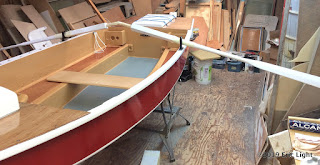The plan is, when the time comes to take the boat out of the shop, to lower it from the mezzanine by rope. So today I set about putting together the lift ropes.
A few days ago, Bruce and I found that when we lifted the boat from the position of the oarlock sockets, the boat was bow-heavy. Bruce suggested using the mast partner as a forward lift point. The main lift will come from a rope that goes (through a couple of pool noodles) around the bottom of the boat and up out the oarlock sockets, with the two sides tied together above the centreline of the boat to make a yoke. The rope is knotted just above the socket on each side, so it won't slip. The yoke is tied to the mast partner to make a pyramid shape.
Today I found a chain-fall lifting mechanism in the shop. With friend Vladi's help, we set it up over the boat. I was then able to lift the boat myself and fine-tune the balance point, setting the boat down each time to re-position the knots.
I had brought my bathroom scale, so I put some foam chunks on top of it and set the boat down on it:
The bathroom scale is the pink and black thing at the bottom of the pile above. You can see that the lifting rope that goes through the pool noodle is slack. I got this picture...
by sliding my iPad in under there.
The boat weighs 140 lbs, about what I expected.




















